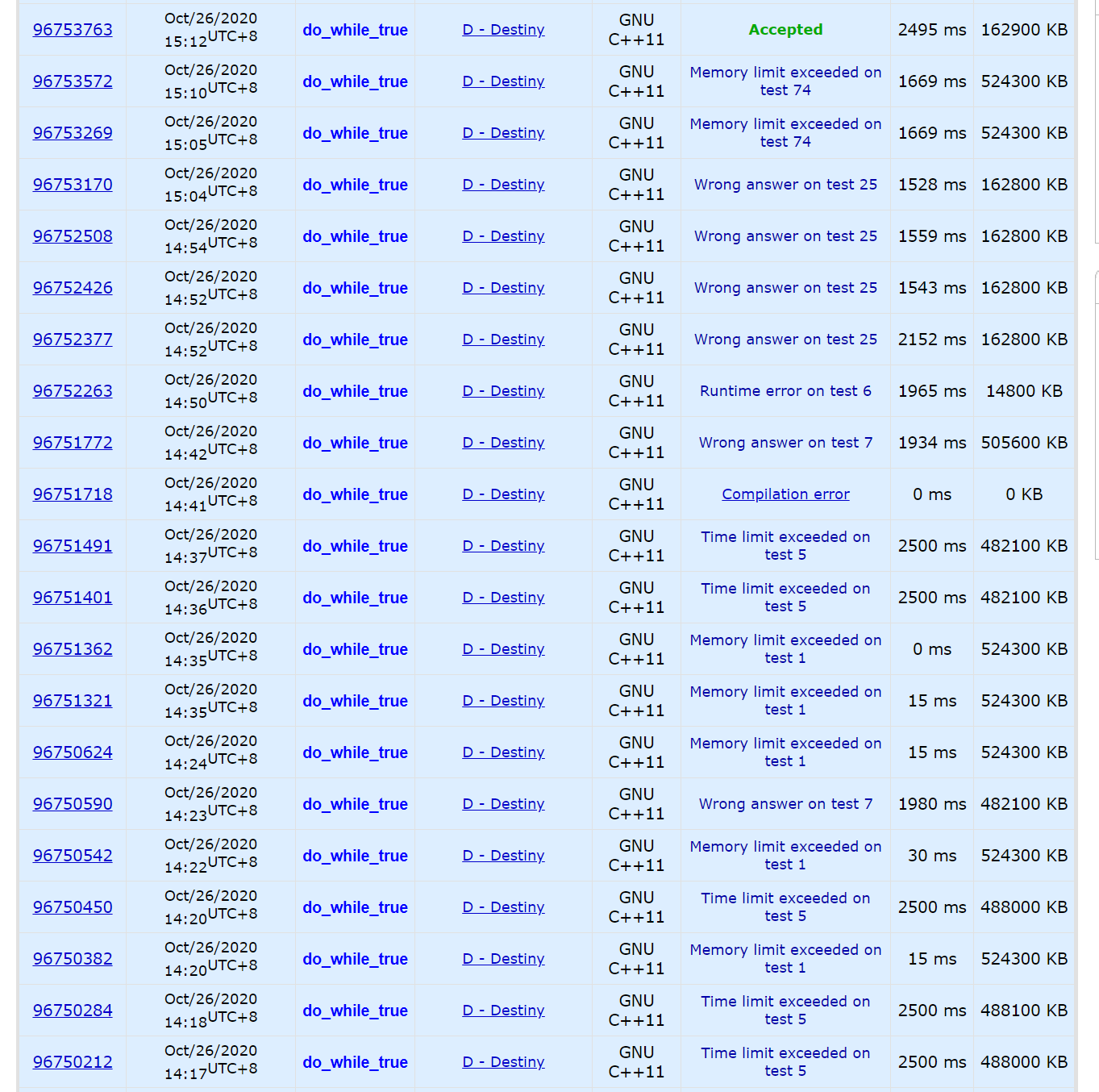Codeforces 840D Destiny
\(\mathcal{Translate}\)
给定长度为 \(n\) 的序列 \(a_1,a_2,...,a_n\),共 \(q\) 次询问,每次询问给定 \(l,r,k\),询问区间 \(a_l,a_{l+1},...,a_{r}\) 的最小的出现次数严格大于 \(\frac{r-l+1}{k}\) 的数的值。
\(1\leq n,q \leq 3\times 10^5,1\leq a_i\leq n,1\leq l\leq r\leq n,2\leq k\leq 5\)
\(\mathcal{Solution}\)
总思路:根号分治卡常数。
设 \(M\) 为一个分界线,询问区间小于等于 \(M\) 的直接暴力扫一遍找,可以使用 unordered_map 做到一次扫 \(\mathcal{O}(M)\)。对于大于 \(M\) 的询问区间,通过记录某些出现次数可以当做答案的数的前缀出现次数和,遍历这些数,如果出现次数合法就更新答案。
那么那些出现次数可以当做答案的数有多少个呢?
只有区间大于等于 \(M\) 的才需要查询,也就是说区间长度最少为 \(M+1\) (后文当作 \(M\),影响不大),而这个询问长度最少是 \(M\),询问的 \(k\) 为 \(5\) 的时候需要的出现次数最少,需要的出现次数为 \(\frac{M}{5}\),这些数最多有 \(\frac{n}{\frac{M}{5}}=\frac{5n}{M}\)。\(q\) 次查询的复杂度为 \(\mathcal{O}(q\times \max\{M,\frac{5n}{M}\})\)。
考虑让里面那个 \(\max\),尽可能小,画出 \(y=x-\frac{5n}{x}\) 的图表可知,\(x=\pm1224.745\) 时 \(y=0\),也就是 \(M\) 取值为 \(1225\) 最优,但是注意前缀和的空间消耗是很大的,即使选择记录下这个数在只需要记录的那些数中的排名,空间消耗也达到了 \(n\times \frac{5n}{M}\) 的级别,会超出空间限制,然而调大 \(M\) 过多又会超出时间限制。
减少空间使用可以考虑前缀出现次数用 vector 来存储,动态开内存,用多少开多少。\(M\) 我调到 \(2200\) 差不多是可以的。
计 \(M_2=\frac{M}{5}\)
时间复杂度 \(\mathcal{O}(nM\log M_2+q\times \max(M,M_2))\)
如果 \(M\) 值取的比较好的话就是 \(\mathcal{O}(n^{1.5}\log{\sqrt{n}+q\sqrt{n}})\)
\(\mathcal{Code}\)
借用了 CYJian 的快读。
#include<iostream>
#include<cstdio>
#include<algorithm>
#include<vector>
#include<cstring>
#include<string>
#include<unordered_map>
#define ll long long
#define pb push_back
#define re register
using namespace std;
#define Min(x, y) (x < y ? x : y)
namespace io {
const int __SIZE = (1 << 21) + 1;
char ibuf[__SIZE], *iS, *iT, obuf[__SIZE], *oS = obuf, *oT = oS + __SIZE - 1, __c, qu[55]; int __f, qr, _eof;
#define Gc() (iS == iT ? (iT = (iS = ibuf) + fread (ibuf, 1, __SIZE, stdin), (iS == iT ? EOF : *iS ++)) : *iS ++)
inline void flush () { fwrite (obuf, 1, oS - obuf, stdout), oS = obuf; }
inline void gc (char &x) { x = Gc(); }
inline void pc (char x) { *oS ++ = x; if (oS == oT) flush (); }
inline void pstr (const char *s) { int __len = strlen(s); for (__f = 0; __f < __len; ++__f) pc (s[__f]); }
inline void gstr (char *s) { for(__c = Gc(); __c < 32 || __c > 126 || __c == ' ';) __c = Gc();
for(; __c > 31 && __c < 127 && __c != ' '; ++s, __c = Gc()) *s = __c; *s = 0; }
template <class I> inline bool gi (I &x) { _eof = 0;
for (__f = 1, __c = Gc(); (__c < '0' || __c > '9') && !_eof; __c = Gc()) { if (__c == '-') __f = -1; _eof |= __c == EOF; }
for (x = 0; __c <= '9' && __c >= '0' && !_eof; __c = Gc()) x = x * 10 + (__c & 15), _eof |= __c == EOF; x *= __f; return !_eof; }
template <class I> inline void print (I x) { if (!x) pc ('0'); if (x < 0) pc ('-'), x = -x;
while (x) qu[++ qr] = x % 10 + '0', x /= 10; while (qr) pc (qu[qr --]); }
struct Flusher_ {~Flusher_(){flush();}}io_flusher_;
} using io::pc; using io::gc; using io::pstr; using io::gstr; using io::gi; using io::print;
const int N = 300010;
int M = 2200, M2 = M/5 - 1;
int n, q;
int a[N], cnt[N], num;
vector<int>sum[N];
vector<int>vec;
unordered_map<int, int>vis;
int main() {
gi(n); gi(q);
for(re int i = 1; i <= n; ++i) {
gi(a[i]), ++cnt[a[i]];
if(cnt[a[i]] == M2 + 1) {
vec.pb(a[i]);
++num;
}
}
sort(vec.begin(), vec.end());
re int x;
for(int j = 0; j <= num; ++j) sum[0].pb(0);
for(re int i = 1; i <= n; ++i) {
sum[i].pb(0);
for(re int j = 1; j <= num; ++j) {
sum[i].pb(0);
sum[i][j] += sum[i-1][j];
}
if(cnt[a[i]] > M2) {
x = lower_bound(vec.begin(), vec.end(), a[i]) - vec.begin() + 1;
++sum[i][x];
}
}
while(q--) {
int l, r, k, sumq = -1;
gi(l); gi(r); gi(k);
if(r - l + 1 <= M) {
vis.clear();
for(re int i = l; i <= r; ++i) {
x = ++vis[a[i]];
if(x > (r - l + 1) / k) sumq = sumq == -1 ? a[i] : Min(sumq, a[i]);
}
}
else {
for(int i = num; i >= 1; --i)
if(sum[r][i] - sum[l-1][i] > (r - l + 1) / k)
sumq = sumq == -1 ? vec[i-1] : Min(sumq, vec[i-1]);
}
print(sumq);pc('\n');
}
return 0;
}
 根号分治卡常数
根号分治卡常数

